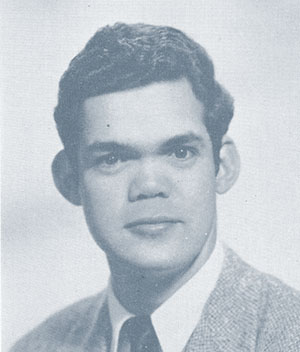SURVIVAL, FREEDOM, AND CHALLENGE
 Just two semesters before commencement, he was drafted. He trained to be a combat engineer in Korea, a role he was told would have a 70 percent casualty rate. A week before deployment, word came down that he and a handful of others would ship out to Germany instead.
Just two semesters before commencement, he was drafted. He trained to be a combat engineer in Korea, a role he was told would have a 70 percent casualty rate. A week before deployment, word came down that he and a handful of others would ship out to Germany instead.
There, his scores on Army exams piqued his superiors’ interest. “I’d been going to Caltech, where survival was taking tests,” he says. “So I was pretty good at it.” Offered several jobs, he opted to tap his mathematical skills and a Caltech survey course to serve as a topographic computer.
 So, in fact, in 1955 he returned home safe and sound. But after years away, could he still hack life at Caltech and complete his degree? It turned out that the Army had given him the key: a dread of rote work in which the higher ranks decide your fate.
So, in fact, in 1955 he returned home safe and sound. But after years away, could he still hack life at Caltech and complete his degree? It turned out that the Army had given him the key: a dread of rote work in which the higher ranks decide your fate.
He was deeply motivated to obtain a credential that would ensure his freedom to choose interesting–and survivable–work. In the winter, he reenrolled, completing his BS in mechanical engineering that December and donning cap and gown in 1956.
FREEDOM!
Free at last, he went from his first job— at Bendix Aviation—right back to school, earning a master’s from USC and an MBA from Stanford. The reason? “My boss would give me something, and zip, I’d hand it back,” he says. “I figured that if I had an advanced degree, I might get more challenges.”
Before he found the perfect challenge, he held a dozen jobs, many at young companies making electronic instruments and devices.
Then, in 1977, while working in La Cañada, he ran into some neighboring JPL engineers. As experts in what was then a space technology—solar panels—they were refining photovoltaics for widespread use on Earth.
"I wanted in," he says. "I thought solar energy was a brilliant idea."
And so he worked at JPL for two decades. Early in his time there, he invited an acquaintance, Suzanne, to join a JPL hiking club trip to his family’s mountain property. The group repaired a dam, and she seemed to sparkle even as she lugged rocks. During and after that trip, Suzanne says, she learned that there was "a lot more to him than just the surface."
After decades of marriage and family life, she still feels that way. "He's one of the most modest intellects," she says. "He has a wide range of knowledge, and it's solid. Whatever he brings up, I know it's accurate. He retains everything."
CHALLENGE
As he recalls, the Reagan administration cut the solar energy program in 1986, believing that American industries would pick up the R&D. Three JPL solar jobs survived; his was one. And he gained his best challenge yet: designing solar arrays for spacecraft, including Sojourner, the first Mars rover. He was in the control room when Sojourner landed in 1997, the year he retired.
"To make me feel even better," he says, "they used my program for calculating power on Mars on the next couple of shots.”
During his time at JPL, he also reconnected with Caltech. When he had an idea he wanted to explore but lacked time and funds, his boss suggested that he host a student in Caltech’s Summer Undergraduate Research Fellowship (SURF) program. He went on to mentor some SURF students and chair many sessions at Caltech’s annual SURF Seminar Day.
"I can't think of a more intelligent program," he says. “The difference it makes in the students’ perspectives is incredible.”
Now, he has expanded his and Suzanne's philanthropy to their alma maters by making a provision in his revocable trust to endow a SURF fellowship. Chair of the reunion committee for the class of ’53 at Caltech's 2018 Reunion Weekend and Seminar Day? None other than this alumnus, Dale Burger.


